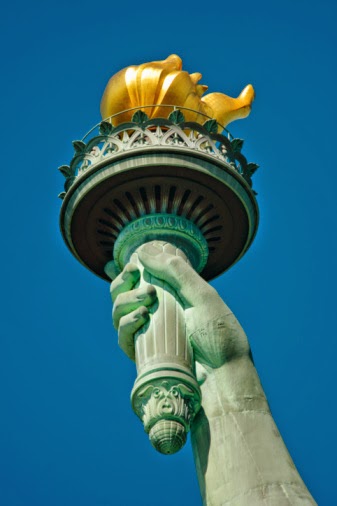Year: 1886
The Statue of Liberty, less well-known by its proper name, "Liberty Enlightening the World" or in French, "La Liberté éclairant le monde" is a neoclassical sculpture that stands on Liberty Island (formerly Bedloe's Island) in the midst of New York Harbor, just south of Manhattan Island.
"The Lady With The Lamp," "Lady Liberty," "Miss Liberty," or "The Lady In The Harbor" is an iconic symbol of the United States of America. At the time it was dedicated, New York Harbor was (as it remains) the key point of entry into the United States for immigrants and visitors, and the sight of the Statue from shipboard, from the air, or simply dominating the harbor, is tremendously evocative for those who come to our shores, and for their descendants. The statue is of a robed female figure representing Libertas, the Roman goddess of freedom, who bears a torch and a tabula ansata (a tablet of laws) upon which is recorded the date of the American Declaration of Independence, July 4, 1776.
The statue is crowned with a seven-pointed diadem representing both the rays of the rising sun, the seven continents, and the seven seas, symbolizing the scope of freedom.
She holds aloft an immense torch in her right hand.
A broken chain (difficult to see from the ground) lies at her feet.
The statue was designed by French sculptor Frédéric Auguste Bartholdi as a Centennial birthday present from the people of France to the people of the United States, reaffirming the bonds between the U.S. and its first ally.
Inspiration for the statue came from many classical sources. "Columbia" is a female representation of the United States, similar in appearance to Miss Liberty.
Libertie is often anthropomorphized as a woman in French art and sculpture, and classical statues of the goddess Libertas were common in the ancient world. Among the most immediate of inspirations was Eugène Delacroix's famed painting, Liberty Leading the People (1830). In this painting, which commemorates France's Revolution of 1830, a half-clothed Liberty leads an armed mob over the bodies of the fallen. Bartholdi, however, wanted to avoid any suggestions that Miss Liberty herself might be violent.
According to tradition, if not to the official history endorsed by the United States government, Bartholdi was moved to create the statue based upon a comment made by a French law professor and politician, Édouard René de Laboulaye in 1865. In the wake of the defeat of the Confederacy in the War Between The States and in the light of the Thirteenth Amendment which abolished American slavery, Laboulaye commented that the Centennial of the United States was barely a decade away, and that any monument raised to the Centennial of American independence would properly be a joint project of the French and American peoples. Considering further, he said, that the monument should be a birthday gift to the United States.
She weighs 450,000 pounds.
She stands 305 feet and one inch tall from ground to torch tip (including the pedestal). The figure herself is 151 feet and one inch tall, making her the largest statue in the world.
She is constructed of 300 huge copper plates sheathing a steel skeleton designed and foundried by George Gustave Eiffel.
Lady Liberty wears a size 879 shoe.
She has a 35-foot waistline.
Her right arm is 42 feet long, her right hand is 16 feet and five inches long, and her index finger is eight feet one inch long.
Her face is 17 feet and three inches long, and her head is ten feet wide.








i would beat the statue of liberty in a 1v1
ReplyDeletethe statue of liberty? more like the statue of SMELLY!!
ReplyDeletepluh
ReplyDeletepoooooooo
ReplyDeleteskibidi!!!!!!!!
ReplyDeletethank you jeff konrei minde for the informative post!
ReplyDeletethank you!
DeleteI find it inspiring how this statue symbolizes freedom for all.
ReplyDeleteolivers toes
ReplyDeletehaydens feet
ReplyDeleteyum
Delete